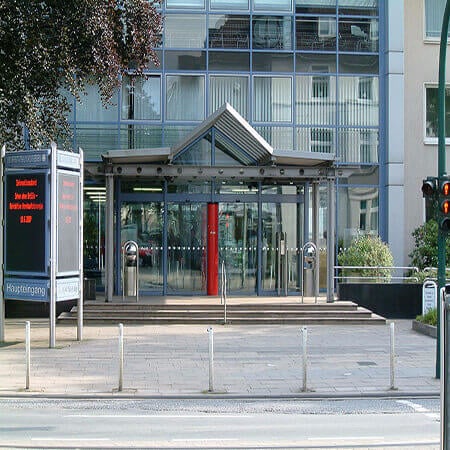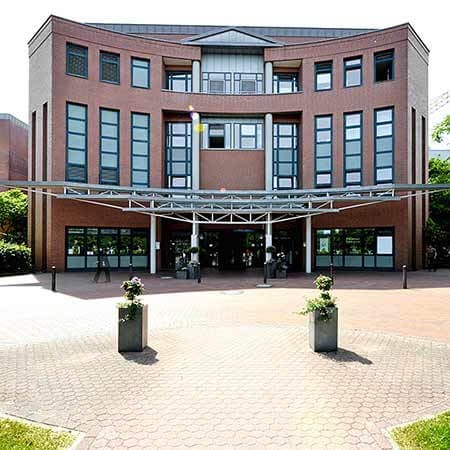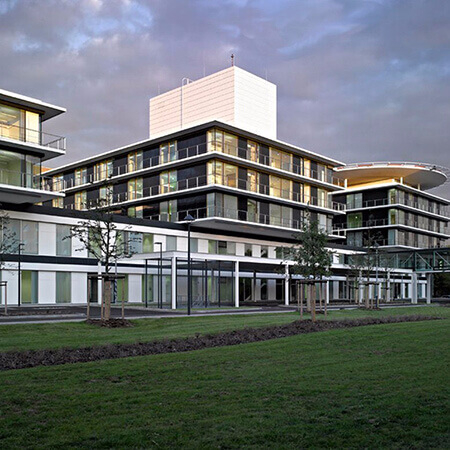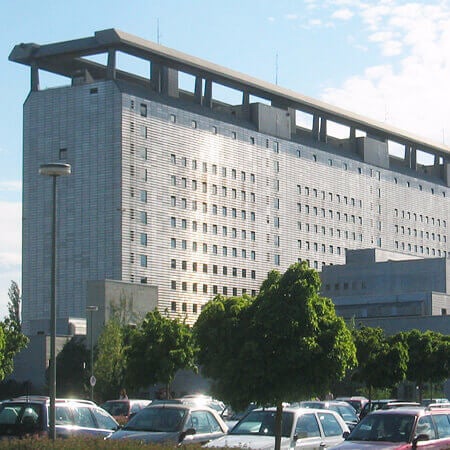Aortic valve insufficiency
Aortic valve insufficiency is an acquired heart defect, the result of which is the regurgitation (backward flow) of blood from the aorta into the left ventricle during the diastole (period of the heart muscle relaxation). This is a very common disease, which occurs among 10% of people over the age of 45. 75% of patients have non-severe stage of the disease, and about 3% of patients are at the severe stage. Aortic valve insufficiency rarely occurs in young age. At the age from 23 to 35 years, the disease occurs in 1.2% of people.
The Booking Health portal presents 33 German clinics specializing in aortic valve insufficiency treatment
Show all clinics
Diagnostics of Aortic valve insufficiency
Diagnostics starts from the physical examination of the patient. Signs that indicate the development of aortic valve insufficiency are:
- Maine sign. The diastolic blood pressure decreases by more than 15 mm Hg, if the patient raises his hand.
- Traube’s sign. Presence of a double tone over the femoral artery in case of its compression.
- Hill’s sign. The blood pressure on the legs is minimum 15 mm Hg higher than on the arms.
- Austin Flint murmur. Presence of the murmur over the top of the heart that imitates mitral stenosis.
- Corrigan’s pulse that is characterized by rapid growth and equally rapid fall of the pulse amplitude at the radial artery.
Instrumental methods of diagnostics, such as:
- ECG. Left ventricular hypertrophy, its dilatation (cavity expansion), signs of ischemia (insufficient blood supply) can be identified during this examination.
- Chest X-ray. The heart has the form of a "boot". The calcification of the aortic valve can occur.
- Echocardiography. Ultrasound examination, including dopplerography, establishes the severity of aortic valve insufficiency. It is classified according to the length of the blood stream which is thrown in the opposite direction, either according to the volume of the regurgitation (percentage of cardiac output).
- MRI is carried out in case of the non-informative results of the echocardiography.
- Cardiac catheterization with angiography is an invasive method of the examination. It is carried out only in case when the data obtained during instrumental examinations contradict to the clinical manifestations and the general condition of the patient.
- Coronary angiography is carried out before the surgical treatment of aortic valve insufficiency, if there is a risk of coronary heart disease.
Best clinics for the aortic valve insufficiency diagnostics in Germany:
Treatment of Aortic valve insufficiency
Treatment can be conservative, as well as surgical. Stable clinical improvement can be achieved only with the surgical methods.
Medications are prescribed to slow down the progression of the heart changes and improve the life quality of the patient. Drugs that reduce the amount of blood regurgitation and increase the heart output are used.
Surgical methods of treatment are:
- Aortic valve prosthesis. It is the basic method of the eliminating the aortic regurgitation. This method significantly increases the patient’s life expectancy and improves its quality. The aim of the surgery is to remove the aortic valve and replace it with the bioprosthesis or a mechanical one.
- Plastic surgery of the aortic valve is a reconstructive surgery that doesn’t require the implantation of the prosthesis. Depending on the situation, the doctor can sew the defects, sew the leaflet at their cleavage, implant a flexible support ring in case of expansion of the fibrous ring, or perform other actions aimed at the restoring of the valve structure.
The advantage of the plastic surgery opposite the prosthetics is that the risk of postoperative complications is significantly reduced, and the patient does not need to take anticoagulants and antiaggregants all his life in order to prevent the thrombosis. But such operation cannot be carried out in all cases. If there are gross violations of the structure of the aortic valve, which cannot be fixed, the doctor has to implant the prosthesis.
Best clinics for the aortic valve insufficiency treatment in Germany:


Rehabilitation after treatment of Aortic valve insufficiency
Cardiological rehabilitation improves the quality of life in patients with cardiovascular diseases. It increases the effectiveness of maintenance treatment in the case of chronic cardiovascular diseases, and also facilitates recovery after exacerbations. Rehabilitation is extremely important in case of cardiosurgical interventions.
Cardiological rehabilitation has the following aims:
- Restoration of heart muscle normal function
- Elimination of symptoms (for example, chest pain, dyspnea, etc.)
- Improving working capacity and providing patient with the opportunity to return to previous professional activities
- Improving physical stamina
- Prevention of exacerbations (including elimination of the risk factors)
- Consulting the patient on self-control and basic principles of self-help
- Improving patient's mental state, ability to "live with the disease"
Effective cardiological rehabilitation is performed only in countries with the developed medicine, as innovative medications, appropriate medical equipment and qualified healthcare professionals are available only there. Basic methods of cardiological rehabilitation include:
- Drug support for normalization of blood pressure, blood clotting, cholesterol level
- Dosed physical exercises under the supervision of an instructor, with a gradual increase in intensity
- Physiotherapy (darsonvalization, electrophoresis with medications, electrosleep, laser and magnetotherapy)
- Relaxing techniques (massage, aromatherapy, acupuncture, psychotherapy)
- Dietotherapy (control of salt and liquid amount, using spices, etc.)
- Modification of lifestyle (smoking cessation, body weight normalization)
In Germany, cardiological rehabilitation undergoes under the constant control of cardiologists, therapists and rehabilitation specialists. Programs are designed for 2 weeks. If necessary, they can last much longer. In this country, the patient is provided with qualitative care, accommodation in comfortable rooms and individually selected meals.
Rehabilitation programs in Germany show one of the best results in the world. Most patients successfully restore their working capacity and excellent health there. They remain physically active, return to the full social and family life.
Best clinics for cardiac rehabilitation in Germany:
Author:
The article was edited by medical expert, board certified Dr. Nadezhda Ivanisova. For the treatment of the conditions referred to in the article you must consult a doctor; the information in the article is not intended for self-medication!
Sources:
ECR - European Cardiology Review
JAHA - Journal of the American Heart Association
The cost of services includes
Here you can find the cost of treatment for this disease at the German University Hospitals. Leave a request and we will provide a free consultation with a doctor and will start organizing the whole treatment process.
The program includes the following:
- Issuing of an invitation for getting a visa for treatment as quick as possible
- Fixing an appointment at a time convenient for you
- Preliminary organization of a comprehensive examination and discussion of the forthcoming treatment plan
- Arranging transfer from the airport to the hospital and back to the airport
- Provision of interpreting services and services of a personal medical coordinator
- If necessary, assistance in the organization of further surgical treatment
- Provision of a medical insurance against treatment complications covering up to 200,000 euro
- Preparation and translation of medical records and recommendations from the hospital
- Assistance in the subsequent communication with your attending physician, including consultations on repeated X-ray images through the unique medical document management system E-doc




